Oscillation Damping Neuro-Based Controllers Augmented Solar Energy Penetration Management of Power System Stability
Abstract
1. Introduction
1.1. Motivation
1.2. Related Work
1.3. Contribution
- Develop two neuro-based controllers to dampen the low-frequency oscillation of the conventional synchronous generators within distributed networks.
- Construct a PV solar energy management strategy to diminish the solar energy’s major impact on the rotor speed and rotor angle of the neighboring synchronous generators.
- Developing a deep neural network-based controller for the SSSC technology to help the PSS and reduce the power system electromechanical oscillations. Since the proposed approach is learning-based, it avoids the nonlinear complexity associated with modern power systems and is considered straightforward yet effective.
- The particle swarm optimization (PSO), which has a high exploitation feature is employed to obtain the optimal numbers of the hidden layers as well as the number of neurons for each layer.
- Implementation of a two-area power system with heavy solar energy penetration in phasor form. Accordingly, an adopted modified PV energy management strategy is developed.
- A fair comparison with the lead-lag and the Matlab/Simulink neuro-fuzzy-based controllers is made to prove the usefulness of the created neuro-based controllers.
1.4. Paper Organization
2. System under Study and Problem Description
2.1. Two-Area Power System Modeling
2.2. Developed Controllers Modeling
2.2.1. Deep Neural Networks Controller
2.2.2. Adaptive Neuro-Fuzzy (ANFIS) Controller
- The fuzzy system is of the first-order Sugeno-type.
- The weighted average defuzzification step produces a single output.
- Each rule carries the same weight as one.
- The AND logic is expressed as a prod, the OR logic is represented by max, the implication is represented by prod, and aggregation is represented by max.
2.2.3. Lead-Lag Compensator
2.3. Solar PV Energy Management System
Control Low of the Solar PV
2.4. Particle Swarm Optimization (PSO)
3. Problem Formulation
Performance Indices
4. Results and Discussion
4.1. Implementation of the Neuro-Based Controllers
4.1.1. Implementation of the ANN Controller
4.1.2. Implementation of the ANFIS Controller
4.2. Case Studies
4.2.1. Case 1: Two-Area Power System with SSSC under Three-Phase Fault
4.2.2. Case 2: Power System Performance with the Solar PV Injection
4.2.3. PV Penetrations Management
4.2.4. Case 3: Two-Area Power System under Heavy Loading
4.2.5. Case 4: Impact of PV Injection with 3-Phase Fault
4.3. Two-Area Power System Performance Indices
5. Conclusions
Author Contributions
Funding
Conflicts of Interest
Appendix A. Parameters of the Particle Swarm Optimizer
Appendix B. Distributed Network
| Quantity | Symbol | Value |
|---|---|---|
| Generators | Rating | P = 2100 MW, P = 1400 MW |
| Terminal voltage | 13.8 kV | |
| [X X X X X X] | [1.305 0.296 0.252 0.474 0.243 0.18] pu | |
| [T T T] | [1.01 0.053 0.1] pu | |
| armature resistance | 2.8544 m | |
| inertia constant (H) | 3.7 sW/VA | |
| Number of poles | 32 | |
| Friction coefficient | 0.0 | |
| PV | Rating | 2100 MW |
| Terminal voltage (rms) | 13.8 kV | |
| Transformer | Rating | 2100 MW |
| [V R L] | [13.8 kV 0.002 0.0 ] | |
| [V R L] | [500 kV 0.002 0.02 ] | |
| [R X] | [500 500 ] | |
| frequency | f | 60 Hz |
| Loads | at bus 1 | 250 MW |
| at bus 2 | 50 MW | |
| at bus 2 | 220 MW + 100 MVAr | |
| at mid-Line 1 | 100 MW | |
| SSSC | Rating | 100 MVA |
| V | 500 kV | |
| V | 40 kV | |
| C | 375 F | |
| R | 0.00533 | |
| L | 0.16 H | |
| Transmission Lines | Line 1 | 150 km + 150 km |
| Line 2 | 280 km | |
| Resistance | 0.00021 pu/km | |
| Reactance | 0.003 pu/km | |
| B | 0.00175 pu/km |
References
- Kumar, R.; Diwania, S.; Khetrapal, P.; Singh, S.; Badoni, M. Multimachine stability enhancement with hybrid PSO-BFOA based PV-STATCOM. Sustain. Comput. Inform. Syst. 2021, 32, 100615. [Google Scholar] [CrossRef]
- Rachananjali, K.; Naik, S.; Bala, K.K.; Srinivasa, R.Y. Efficient modeling and simulation of grid connected MMC for sustainable photovoltaic and wind conversion system. Sustain. Comput. Inform. Syst. 2020, 28, 100402. [Google Scholar]
- Banaei, M.; Toloue, H.; Kazemi, F.M.; Oskuee, M.R.J. Damping of power system oscillations using imperialist competition algorithm in power system equipped by HVDC. Ain Shams Eng. J. 2015, 6, 75–84. [Google Scholar] [CrossRef]
- Moradi, M.H.; Amiri, F. Virtual inertia control in islanded microgrid by using robust model predictive control (RMPC) with considering the time delay. Soft Comput. 2021, 25, 6653–6663. [Google Scholar] [CrossRef]
- Saadatmand, M.; Gharehpetian, G.B.; Kamwa, I.; Siano, P.; Guerrero, J.M.; Haes Alhelou, H. A Survey on FOPID controllers for LFO damping in Power systems using synchronous generators, FACTS devices and inverter-based power plants. Energies 2021, 14, 5983. [Google Scholar] [CrossRef]
- Ortega, R.; García, V.H.; García-García, A.L.; Rodriguez, J.J.; Vásquez, V.; Sosa-Savedra, J.C. Modeling and Application of Controllers for a Photovoltaic Inverter for Operation in a Microgrid. Sustainability 2021, 13, 5115. [Google Scholar] [CrossRef]
- Pathan, M.I.H.; Rana, M.J.; Shahriar, M.S.; Shafiullah, M.; Zahir, M.H.; Ali, A. Real-time LFO damping enhancement in electric networks employing PSO optimized ANFIS. Inventions 2020, 5, 61. [Google Scholar] [CrossRef]
- Patsalides, M.; Papadimitriou, C.N.; Efthymiou, V. Low Inertia Systems Frequency Variation Reduction with Fine-Tuned Smart Energy Controllers. Sustainability 2021, 13, 2979. [Google Scholar] [CrossRef]
- Nikolaev, N.; Dimitrov, K.; Rangelov, Y. A Comprehensive Review of Small-Signal Stability and Power Oscillation Damping through Photovoltaic Inverters. Energies 2021, 14, 7372. [Google Scholar] [CrossRef]
- Gheisarnejad, M.; Khooban, M.H. Secondary load frequency control for multi-microgrids: HiL real-time simulation. Soft Comput. 2019, 23, 5785–5798. [Google Scholar] [CrossRef]
- Saleem, B.; Badar, R.; Judge, M.A.; Manzoor, A.; ul Islam, S.; Rodrigues, J.J. Adaptive recurrent NeuroFuzzy control for power system stability in smart cities. Sustain. Energy Technol. Assess. 2021, 45, 101089. [Google Scholar] [CrossRef]
- Mahendran, K.; Prabha, S. Optimal control strategies for a hybrid renewable energy system: An ALANN/RNN technique. Soft Comput. 2019, 23, 13459–13475. [Google Scholar] [CrossRef]
- Yousef, A.M.; Abo-Elyousr, F.K.; Elnozohy, A.; Mohamed, M.; Abdelwahab, S.A.M. Fractional Order PI Control in Hybrid Renewable Power Generation System to Three Phase Grid Connection. Int. J. Electr. Eng. Inform. 2020, 12, 470–493. [Google Scholar] [CrossRef]
- Abo-Elyousr, F.K.; Abbas, H.S.; Yousef, A.M.; Quynh, N.V.; Ali, Z.M.; Nazir, M.S. Oscillation Damping for Wind Energy Conversion System with Doubly Fed Induction Generator Association with Synchronous Generator. Energies 2020, 13, 5067. [Google Scholar] [CrossRef]
- Çelik, E. Design of new fractional order PI–fractional order PD cascade controller through dragonfly search algorithm for advanced load frequency control of power systems. Soft Comput. 2021, 25, 1193–1217. [Google Scholar] [CrossRef]
- Sahoo, S.; Jena, N.K.; Ray, P.K.; Sahu, B.K. Selfish Herd Optimisation tuned fractional order cascaded controllers for AGC Analysis. Soft Comput. 2021, 26, 2835–2853. [Google Scholar] [CrossRef]
- Abo-Elyousr, F.K.; Abdelaziz, A.Y. A Novel modified robust load frequency control for mass-less inertia photovoltaics penetrations via hybrid PSO-WOA approach. Electr. Power Components Syst. 2019, 47, 1744–1758. [Google Scholar] [CrossRef]
- Lei, B.; Fei, S. A brand new nonlinear robust control design of SSSC for transient stability and damping improvement of multi-machine power systems via pseudo-generalized Hamiltonian theory. Control. Eng. Pract. 2014, 29, 147–157. [Google Scholar] [CrossRef]
- Sonfack, L.L.; Kenné, G.; Fombu, A.M. An improved adaptive RBF neuro-sliding mode control strategy: Application to a static synchronous series compensator controlled system. Int. Trans. Electr. Energy Syst. 2019, 29, e2835. [Google Scholar] [CrossRef]
- Maleki, H.; Varma, R.K. Coordinated control of PV solar system as STATCOM (PV-STATCOM) and Power System Stabilizers for power oscillation damping. In Proceedings of the 2016 IEEE Power and Energy Society General Meeting (PESGM), Boston, MA, USA, 17–21 July 2016; pp. 1–5. [Google Scholar]
- Cabrera-Tobar, A.; Bullich-Massagué, E.; Aragüés-Pe nalba, M.; Gomis-Bellmunt, O. Active and reactive power control of a PV generator for grid code compliance. Energies 2019, 12, 3872. [Google Scholar] [CrossRef]
- Ambafi, J.G.; Adamu, S.S. Optimal siting, sizing, and parameter tuning of STATCOM and SSSC using MPSO and remote coordination of the FACTS for oscillation damping of power systems. Turk. J. Electr. Eng. Comput. Sci. 2019, 27, 4580–4595. [Google Scholar] [CrossRef]
- Panda, S.; Padhy, N.; Patel, R. Power-system stability improvement by PSO optimized SSSC-based damping controller. Electr. Power Components Syst. 2008, 36, 468–490. [Google Scholar] [CrossRef]
- Ghatak, A.; Pandit, T.; Ramanathan, V. Comparative Analysis of Control Systems of Distribution Static Synchronous Compensator. In Proceedings of the 2021 2nd International Conference on Smart Electronics and Communication (ICOSEC), Trichy, India, 7–9 October 2021; pp. 512–517. [Google Scholar]
- Kar, M.K.; Kumar, S.; Singh, A.K.; Panigrahi, S. A modified sine cosine algorithm with ensemble search agent updating schemes for small signal stability analysis. Int. Trans. Electr. Energy Syst. 2021, 31, e13058. [Google Scholar] [CrossRef]
- Hemeida, M.; Rezk, H.; Hamada, M.M. A comprehensive comparison of STATCOM versus SVC-based fuzzy controller for stability improvement of wind farm connected to multi-machine power system. Electr. Eng. 2018, 100, 935–951. [Google Scholar] [CrossRef]
- Roy, R.; Mukherjee, V.; Singh, R.P. Harris hawks optimization algorithm for model order reduction of interconnected wind turbines. ISA Trans. 2021, 128, 372–385. [Google Scholar] [CrossRef]
- Sakipour, R.; Abdi, H. Voltage stability improvement of wind farms by self-correcting static volt-ampere reactive compensator and energy storage. Int. J. Electr. Power Energy Syst. 2022, 140, 108082. [Google Scholar] [CrossRef]
- Abdelsattar, M.; Arafa Hafez, W.; A. Elbaset, A.; Kamel, S.; H. Kasem Alaboudy, A.; Khan, B.; A. Zaki Diab, A. Voltage stability improvement of an Egyptian power grid-based wind energy system using STATCOM. Wind Energy 2022, 25, 1077–1120. [Google Scholar] [CrossRef]
- Tavakoli, A.R.; Seifi, A.R.; Arefi, M.M. Fuzzy-PSS and fuzzy neural network non-linear PI controller-based SSSC for damping inter-area oscillations. Trans. Inst. Meas. Control. 2018, 40, 733–745. [Google Scholar] [CrossRef]
- Tavakoli, A.R.; Seifi, A.R.; Arefi, M.M. Designing a self-constructing fuzzy neural network controller for damping power system oscillations. Fuzzy Sets Syst. 2019, 356, 63–76. [Google Scholar] [CrossRef]
- Shi, Z.; Yao, W.; Li, Z.; Zeng, L.; Zhao, Y.; Zhang, R.; Tang, Y.; Wen, J. Artificial intelligence techniques for stability analysis and control in smart grids: Methodologies, applications, challenges and future directions. Appl. Energy 2020, 278, 115733. [Google Scholar] [CrossRef]
- Badar, R.; Dilshad, S. Type-II neuro fuzzy wavelet control for power system stability enhancement using STATCOM. In Proceedings of the 2016 19th International Multi-Topic Conference (INMIC), Islamabad, Pakistan, 5–6 December 2016; pp. 1–7. [Google Scholar]
- Abas, N.; Dilshad, S.; Khalid, A.; Saleem, M.S.; Khan, N. Power quality improvement using dynamic voltage restorer. IEEE Access 2020, 8, 164325–164339. [Google Scholar] [CrossRef]
- Jolfaei, M.G.; Sharaf, A.M.; Shariatmadar, S.M.; Poudeh, M.B. A hybrid PSS–SSSC GA-stabilization scheme for damping power system small signal oscillations. Int. J. Electr. Power Energy Syst. 2016, 75, 337–344. [Google Scholar] [CrossRef]
- Sahu, P.R.; Hota, P.K.; Panda, S. Modified whale optimization algorithm for coordinated design of fuzzy lead-lag structure-based SSSC controller and power system stabilizer. Int. Trans. Electr. Energy Syst. 2019, 29, e2797. [Google Scholar] [CrossRef]
- Gurung, S.; Naetiladdanon, S.; Sangswang, A. Coordination of power-system stabilizers and battery energy-storage system controllers to improve probabilistic small-signal stability considering integration of renewable-energy resources. Appl. Sci. 2019, 9, 1109. [Google Scholar] [CrossRef]
- Ibrahim, Y.; Kamel, S.; Rashad, A.; Nasrat, L.; Jurado, F. Performance Enhancement of Wind Farms Using Tuned SSSC Based on Artificial Neural Network. Int. J. Interact. Multim. Artif. Intell. 2019, 5, 118–124. [Google Scholar] [CrossRef]
- Badar, R.; Khan, L. Power system oscillations damping using HABsW based FACTS-SSSC. J. Intell. Fuzzy Syst. 2014, 27, 1575–1587. [Google Scholar] [CrossRef]
- Badar, R.; Khan, M.Z.; Javed, M.A. MIMO adaptive bspline-based wavelet neurofuzzy control for multi-type facts. IEEE Access 2020, 8, 28109–28122. [Google Scholar] [CrossRef]
- Gholipour, E.; Nosratabadi, S.M. A new coordination strategy of SSSC and PSS controllers in power system using SOA algorithm based on Pareto method. Int. J. Electr. Power Energy Syst. 2015, 67, 462–471. [Google Scholar] [CrossRef]
- Nahak, N.; Satapathy, O. Investigation and damping of electromechanical oscillations for grid integrated micro grid by a novel coordinated governor-fractional power system stabilizer. Energy Sources Part A Recover. Util. Environ. Eff. 2021, 1–29. [Google Scholar] [CrossRef]
- Waseem, M.; Lin, Z.; Liu, S.; Zhang, Z.; Aziz, T.; Khan, D. Fuzzy compromised solution-based novel home appliances scheduling and demand response with optimal dispatch of distributed energy resources. Appl. Energy 2021, 290, 116761. [Google Scholar] [CrossRef]
- Waseem, M.; Lin, Z.; Liu, S.; Sajjad, I.A.; Aziz, T. Optimal GWCSO-based home appliances scheduling for demand response considering end-users comfort. Electr. Power Syst. Res. 2020, 187, 106477. [Google Scholar] [CrossRef]
- Balouch, S.; Abrar, M.; Abdul Muqeet, H.; Shahzad, M.; Jamil, H.; Hamdi, M.; Malik, A.; Hamam, H. Optimal Scheduling of Demand Side Load Management of Smart Grid Considering Energy Efficiency. Front. Energy Res. 2022, 10, 861571. [Google Scholar]
- Elnozahy, A.; Abd-Elbary, H.; Abo-Elyousr, F.K. Efficient energy harvesting from PV Panel with reinforced hydrophilic nano-materials for eco-buildings. Energy Built Environ. 2022, in press. [Google Scholar] [CrossRef]
- Ramadan, H.S.; Helmi, A.M.; Abo-Elyousr, F.K. Optimal resilient facade thermal photovoltaic clustering allocation for microgrid enhanced voltage profile. Int. J. Electr. Power Energy Syst. 2023, 148, 108940. [Google Scholar] [CrossRef]
- SSSC (Phasor Model). Available online: https://www.mathworks.com/help/physmod/sps/ug/sssc-phasor-model.html/ (accessed on 13 March 2022).
- Abo-Elyousr, F.K.; Nassrat, L. Evaluation of flashover voltage levels of contaminated hydrophobic polymer insulators using regression trees, neural networks, and adaptive neuro-fuzzy. Telkomnika 2018, 16, 495–512. [Google Scholar] [CrossRef]
- Renjini, G.; Devi, V. Artificial neural network controller based cleaner battery-less fuel cell vehicle with EF2 resonant DC-DC converter. Sustain. Comput. Inform. Syst. 2022, 35, 100667. [Google Scholar]
- Ramezani, F.; Nikoo, M.; Nikoo, M. Artificial neural network weights optimization based on social-based algorithm to realize sediment over the river. Soft Comput. 2015, 19, 375–387. [Google Scholar] [CrossRef]
- Chatterjee, S.; Das, A. A novel systematic approach to diagnose brain tumor using integrated type-II fuzzy logic and ANFIS (adaptive neuro-fuzzy inference system) model. Soft Comput. 2020, 24, 11731–11754. [Google Scholar] [CrossRef]
- Suparta, W.; Putro, W.S. Comparison of tropical thunderstorm estimation between multiple linear regression, Dvorak, and ANFIS. Bull. Electr. Eng. Inform. 2017, 6, 149–158. [Google Scholar] [CrossRef]
- Fetzer, D. Development of a MATLAB/Simulink Framework for Phasor-Based Power System Simulation and Component Modeling Based on State Machines; Kassel University Press GmbH: Kassel, Germany, 2018; Volume 7. [Google Scholar]
- Abo-Elyousr, F.K.; Sharaf, A.M. A novel modified robust load frequency controller scheme. Energy Syst. 2020, 11, 1175–1198. [Google Scholar] [CrossRef]
- Train Adaptive Neuro-Fuzzy Inference Systems. Available online: https://www.mathworks.com/help/fuzzy/train-adaptive-neuro-fuzzy-inference-systems-gui.html (accessed on 13 March 2022).
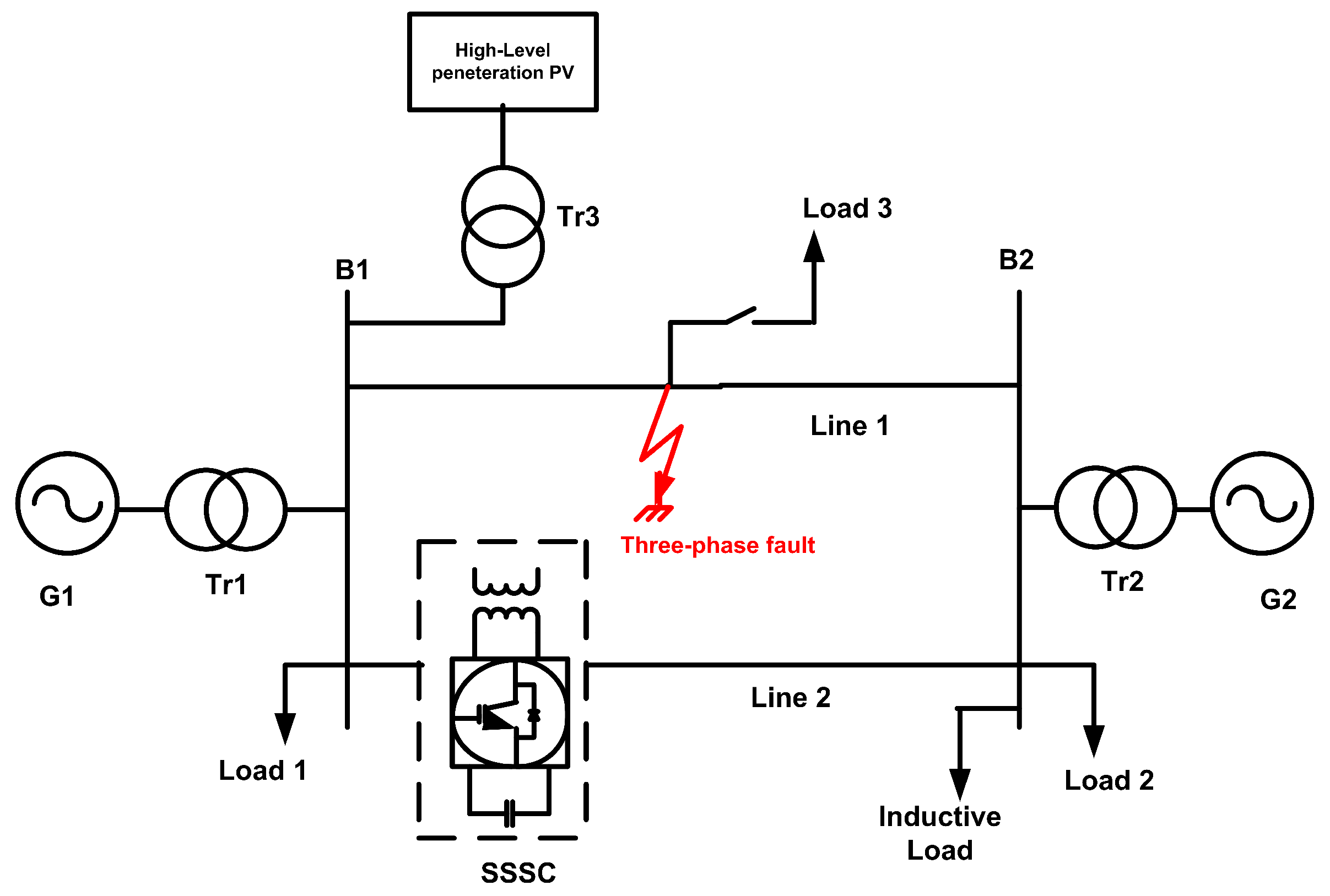
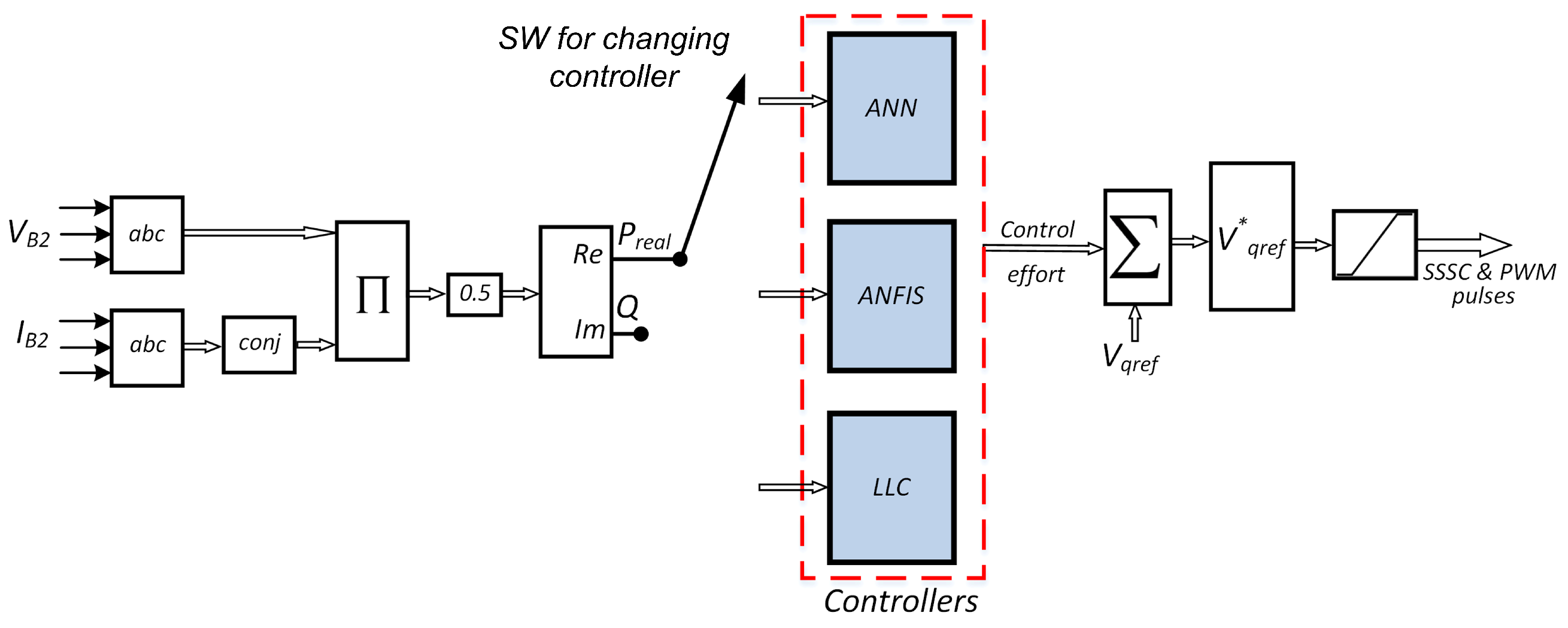
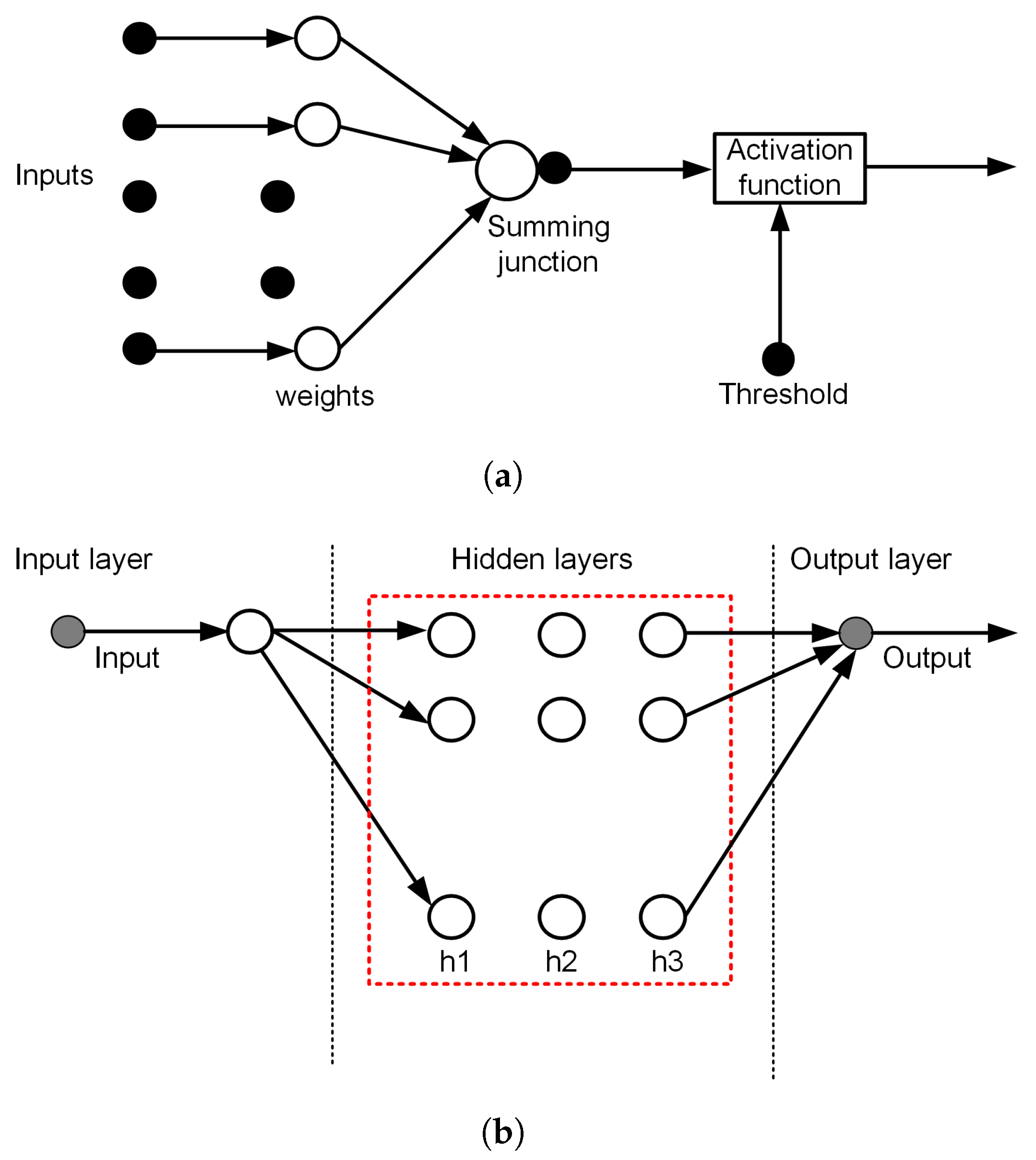
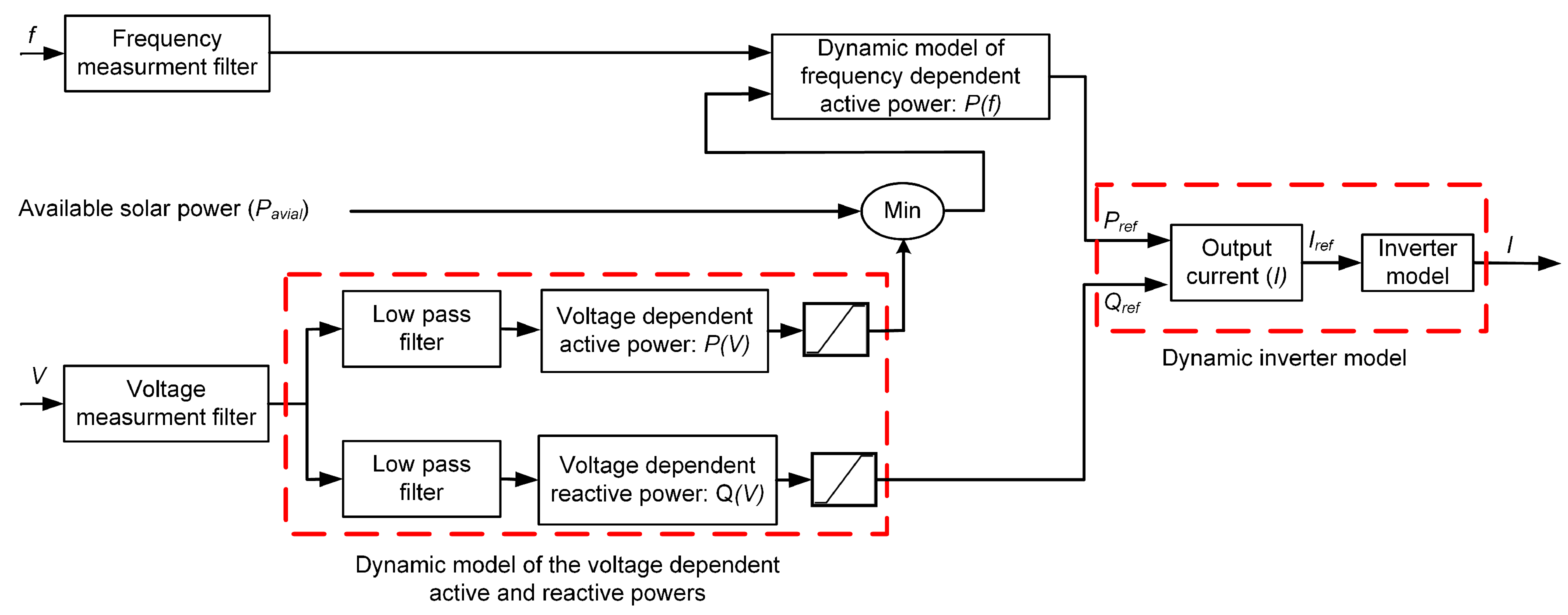
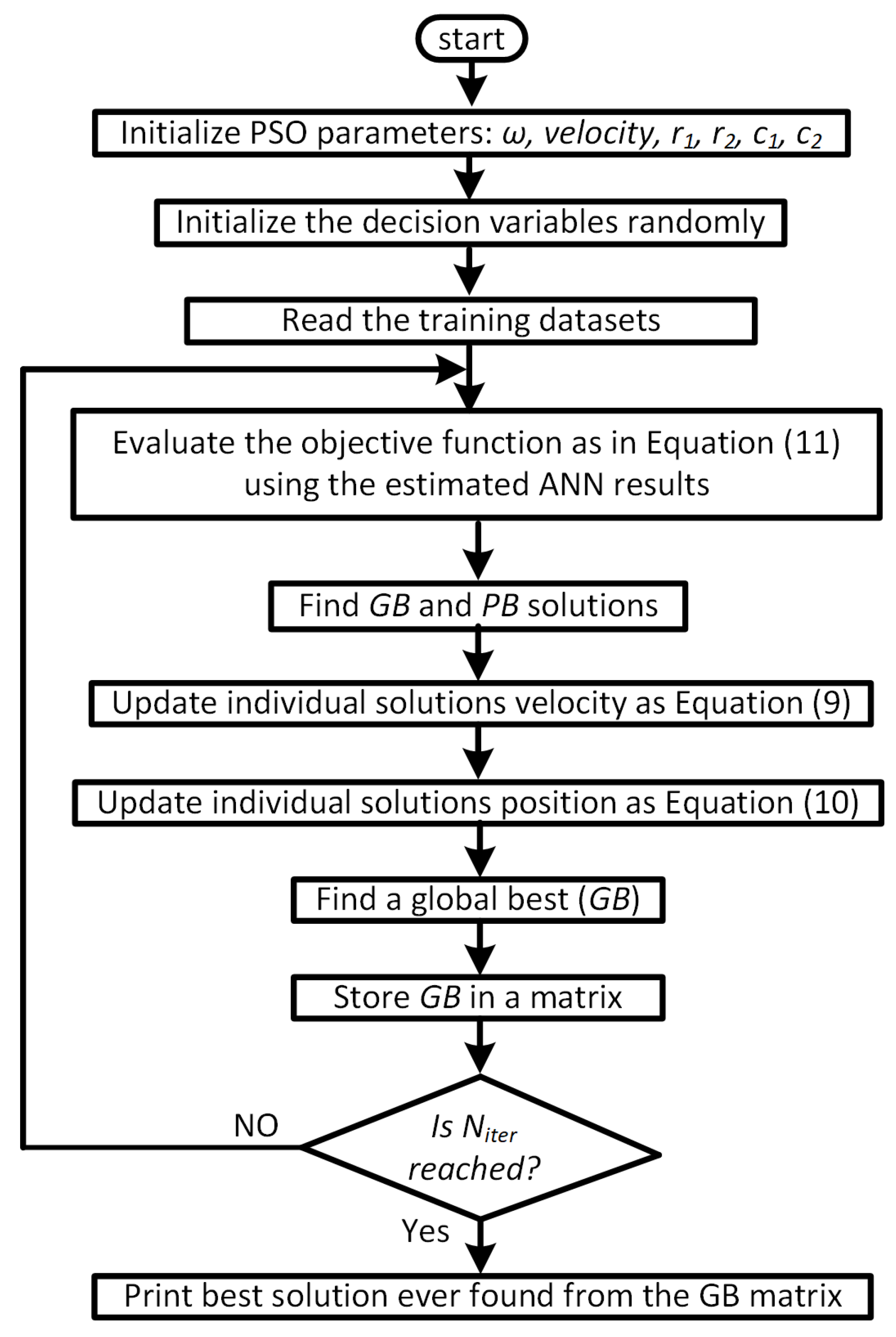

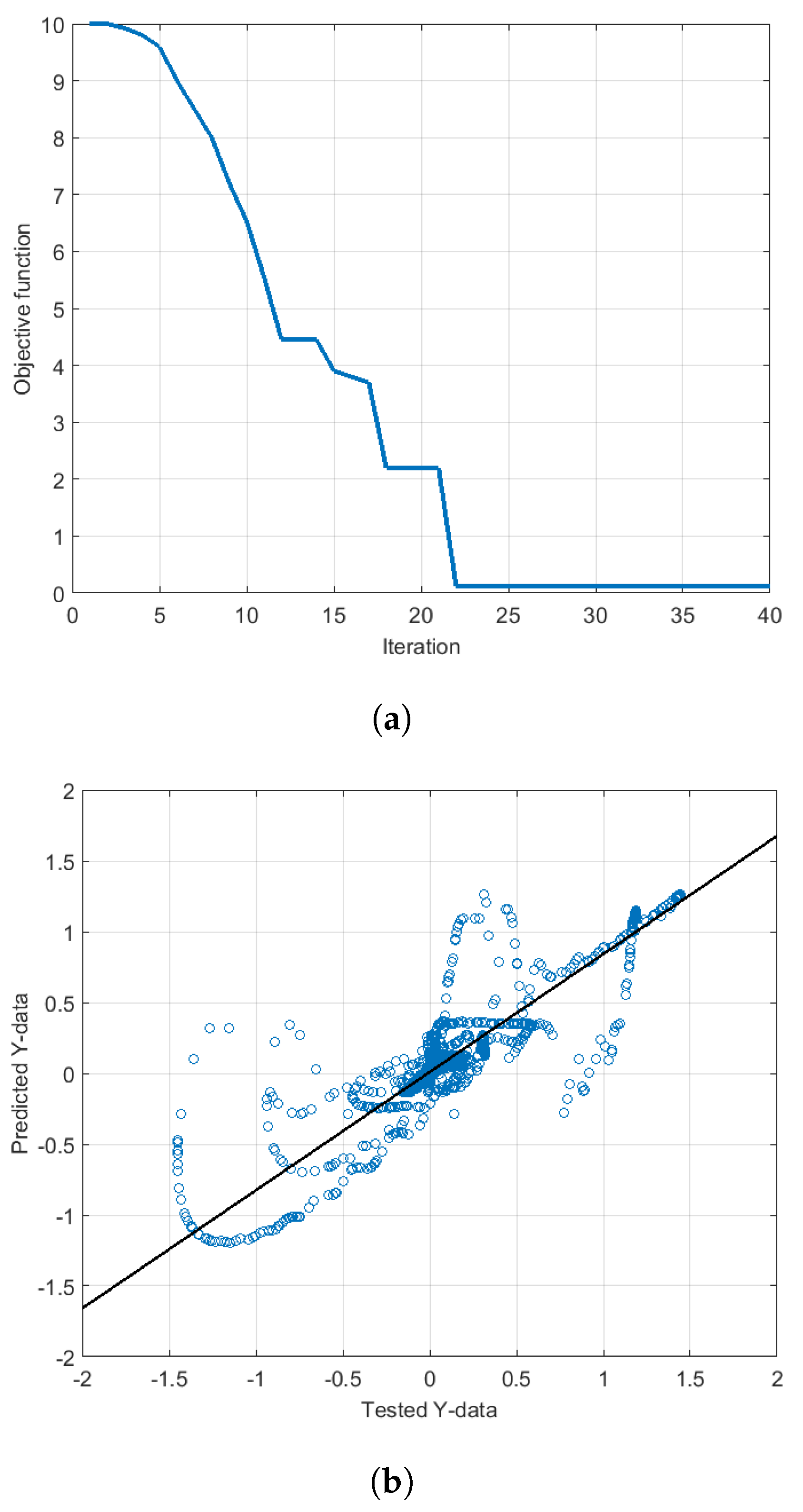
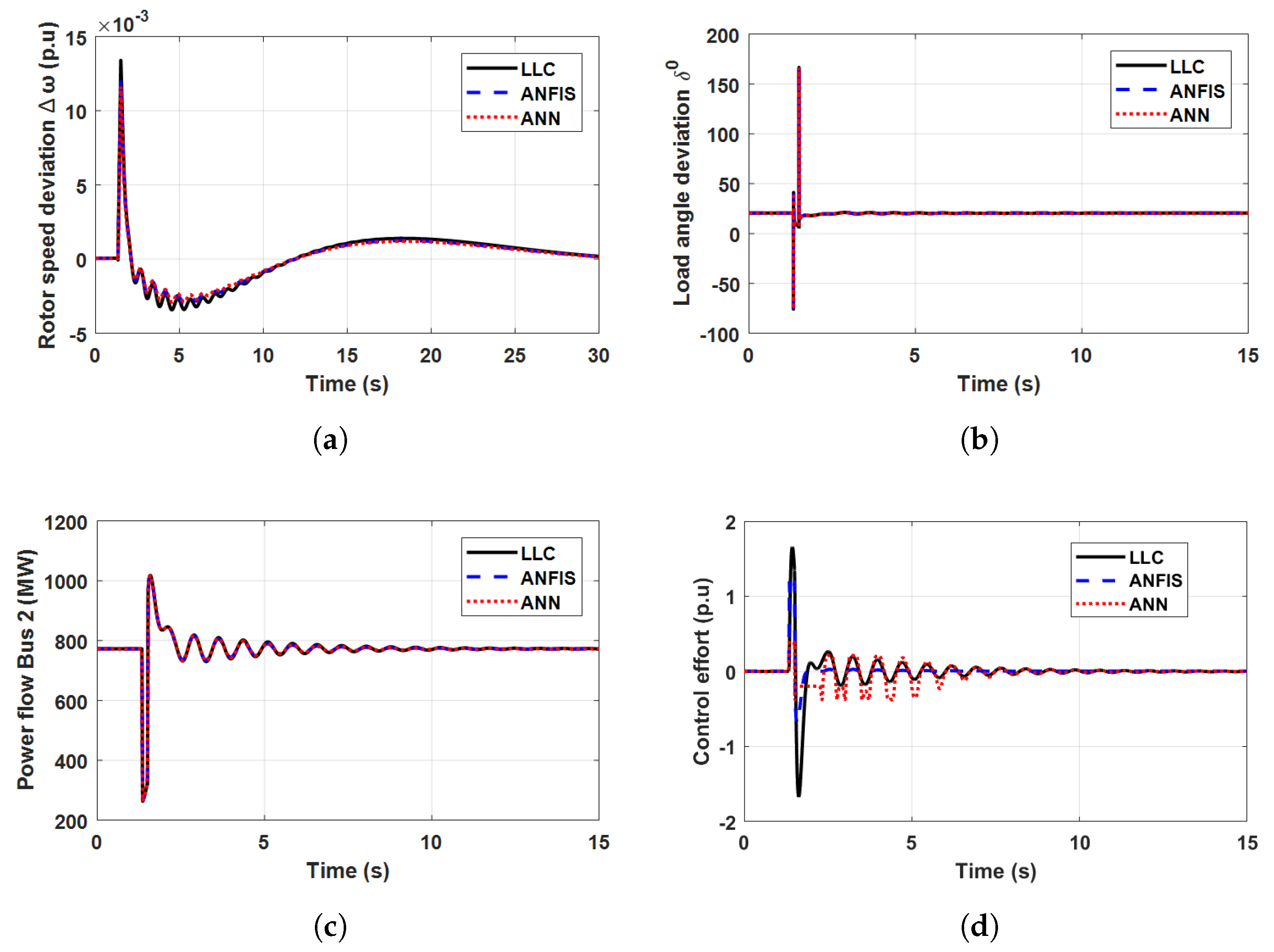
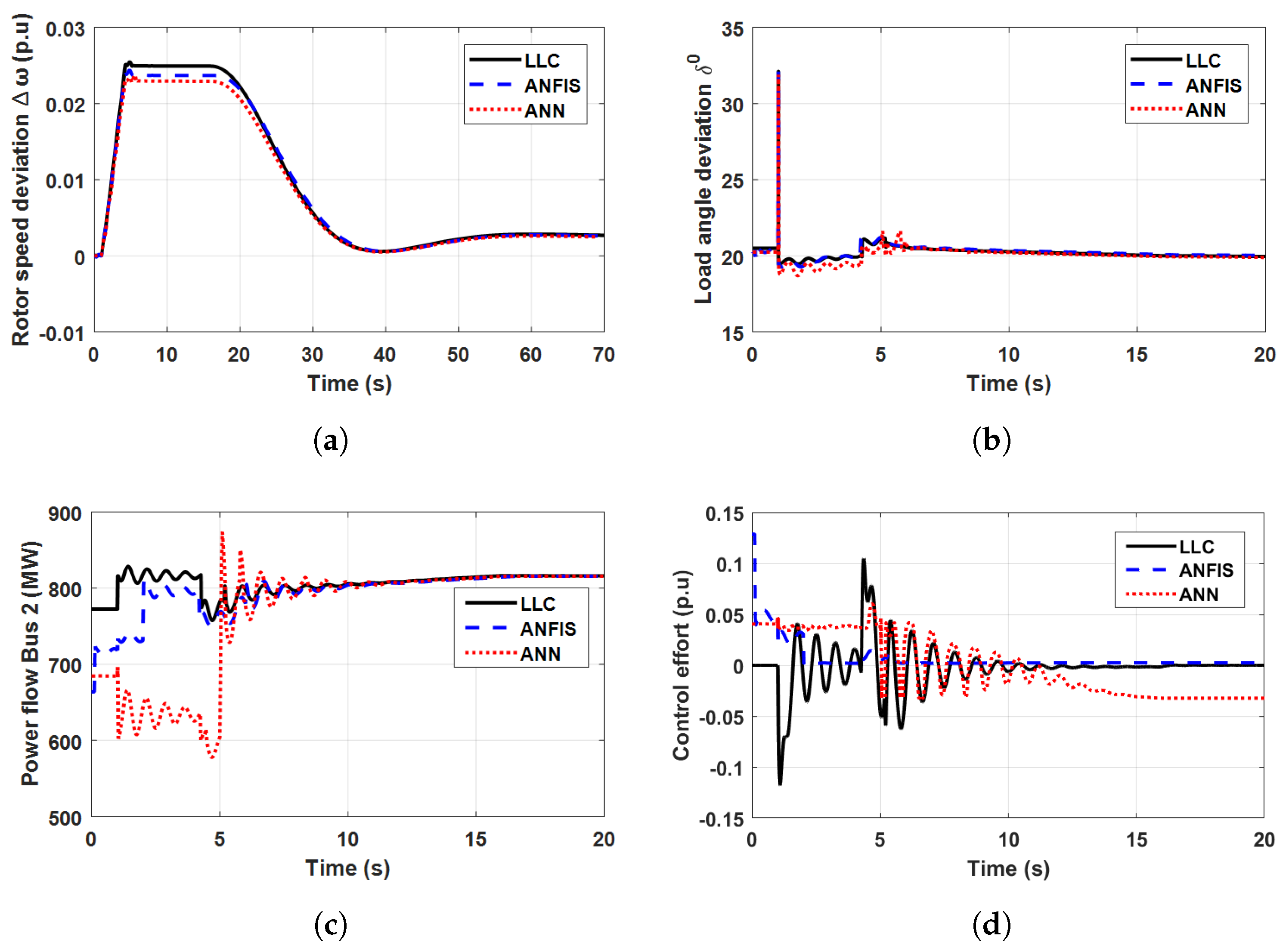

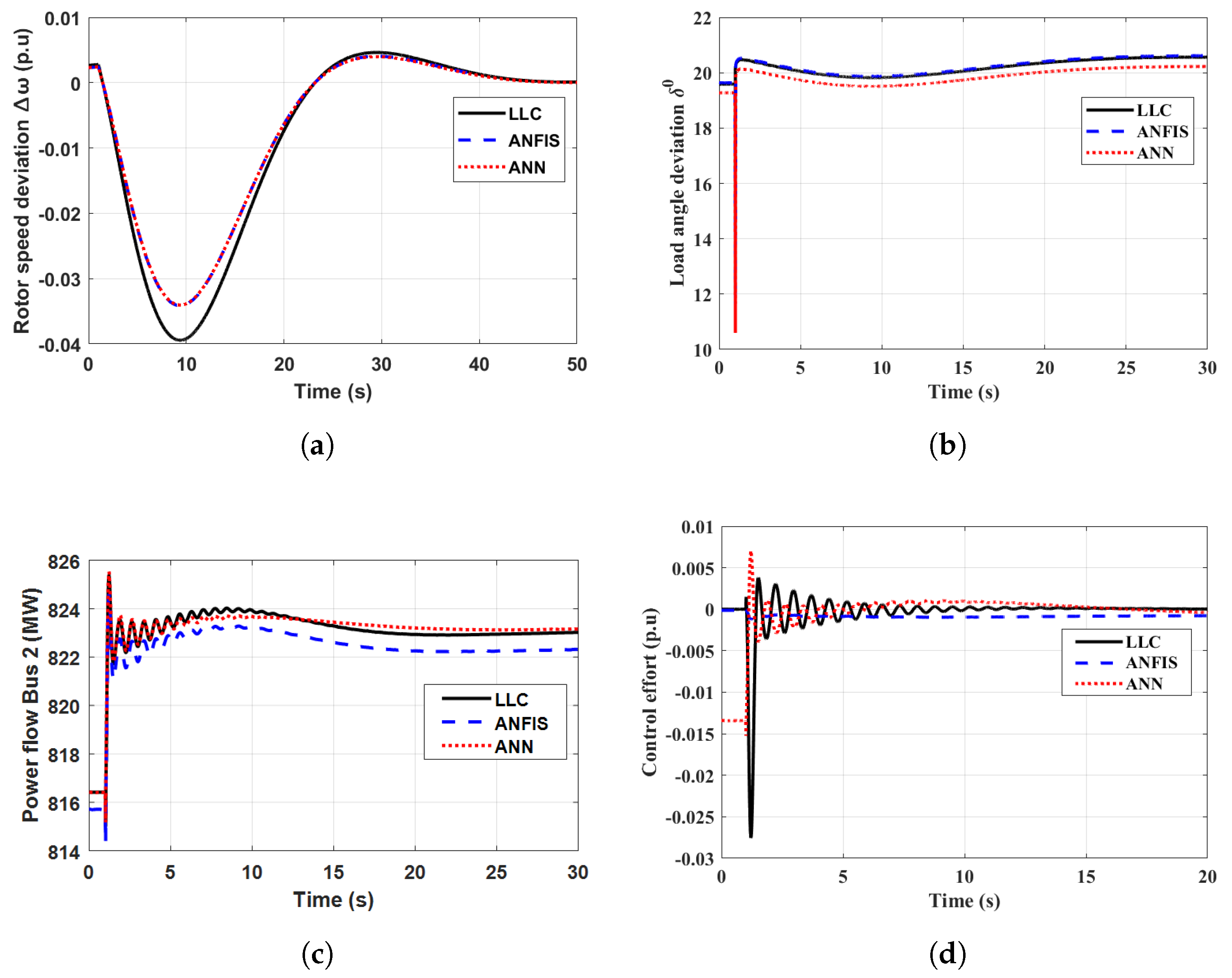
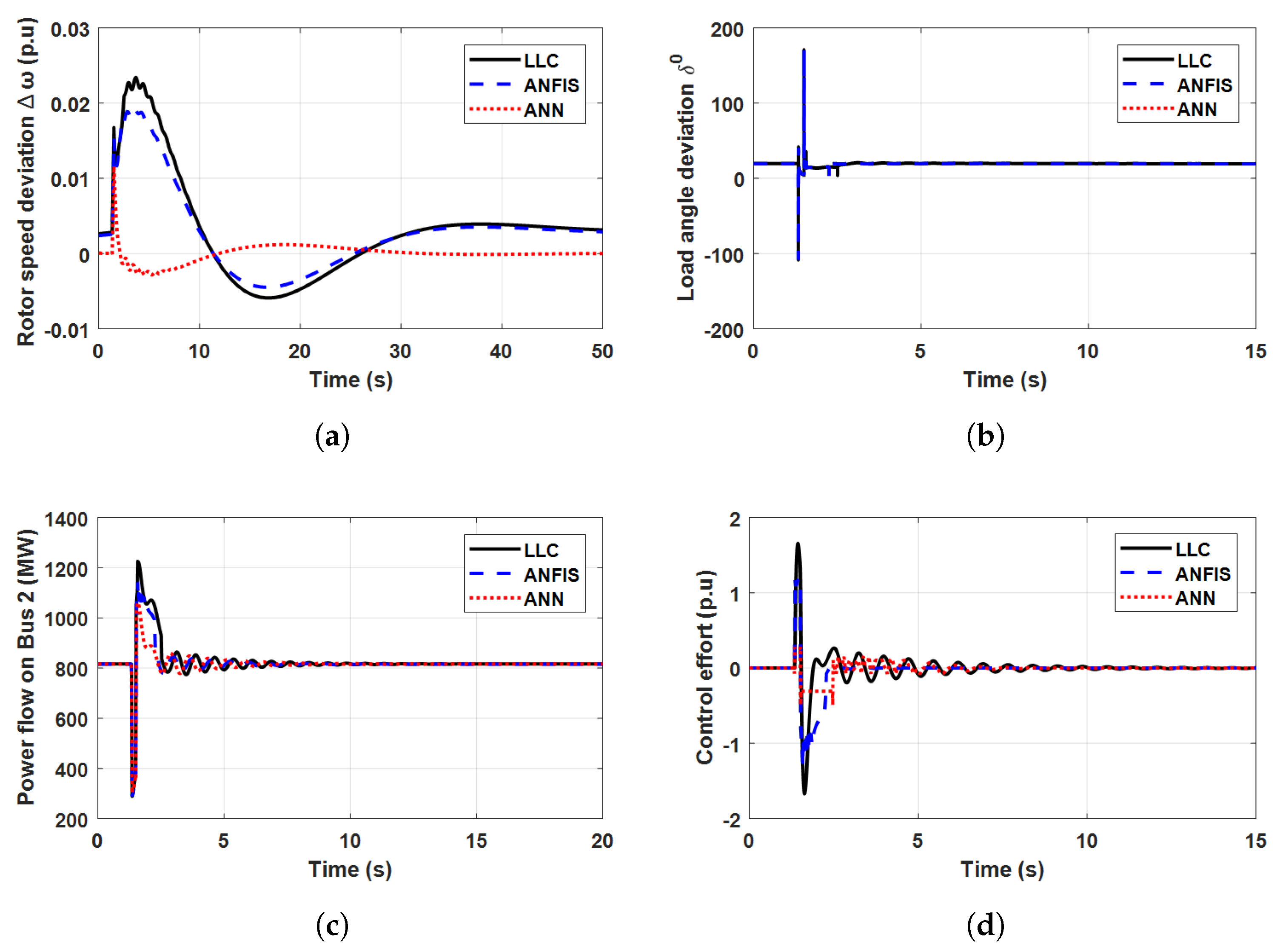
| Parameter | Value |
|---|---|
| number of layers | 4 |
| number of hidden layers | 3 |
| number of neurons per layer | (10,7,4,1) |
| number of inputs | 1 |
| number of outputs | 1 |
| number of weightings | 134 |
| Training function | Levenberg–Marquardt backpropagation |
| Parameter | Value |
|---|---|
| Number of nodes | 16 |
| Number of linear parameters | 6 |
| Number of nonlinear parameters | 9 |
| Number of nonlinear parameters | 9 |
| Number of training data pairs | 75,236 |
| Number of fuzzy rules | 3 |
| Membership function type | gbellmf |
| Number of epoches | 40 |
| Parameter | ANN | ANFIS |
|---|---|---|
| RMSE | 0.119 | 0.143 |
| RE | 2.196 | 2.723 |
| R | 0.917 | 0.879 |
| Case | Controller | IAE | ISE | ITAE | ITSE | Execution Time (s) |
|---|---|---|---|---|---|---|
| Case 1, three phase fault | LLC | 1.27 | 0.6385 | 32.5 | 31.28 | |
| ANFIS | 0.707 | 0.2327 | 36 | 11.88 | ||
| ANN | 1.4 | 0.21 | 31.4 | 10.72 | ||
| Case 2, impact of PV | LLC | 0.526 | 0.044 | 13.1 | 0.56 | |
| ANFIS | 0.33 | 0.005 | 12.37 | 0.0018 | ||
| ANN | 0.23 | 0.0012 | 8.485 | 0.0016 | ||
| Case 3, impact of load variation | LLC | 0.3332 | 0.049 | 1.6 | 0.044 | |
| ANFIS | 0.06338 | 0.0031 | 0.66 | 0.019 | ||
| ANN | 0.0098 | 0.00103 | 0.54 | 0.014 | ||
| Case 4, impact of PV with severe fault | LLC | 1.476 | 0.9758 | 61.8 | 48 | |
| ANFIS | 1.25 | 0.6824 | 52.44 | 35.14 | ||
| ANN | 1.2 | 0.2855 | 51.4 | 10.72 |
Disclaimer/Publisher’s Note: The statements, opinions and data contained in all publications are solely those of the individual author(s) and contributor(s) and not of MDPI and/or the editor(s). MDPI and/or the editor(s) disclaim responsibility for any injury to people or property resulting from any ideas, methods, instructions or products referred to in the content. |
© 2023 by the authors. Licensee MDPI, Basel, Switzerland. This article is an open access article distributed under the terms and conditions of the Creative Commons Attribution (CC BY) license (https://creativecommons.org/licenses/by/4.0/).
Share and Cite
Aref, M.; Abdelaziz, A.Y.; Geem, Z.W.; Hong, J.; Abo-Elyousr, F.K. Oscillation Damping Neuro-Based Controllers Augmented Solar Energy Penetration Management of Power System Stability. Energies 2023, 16, 2391. https://doi.org/10.3390/en16052391
Aref M, Abdelaziz AY, Geem ZW, Hong J, Abo-Elyousr FK. Oscillation Damping Neuro-Based Controllers Augmented Solar Energy Penetration Management of Power System Stability. Energies. 2023; 16(5):2391. https://doi.org/10.3390/en16052391
Chicago/Turabian StyleAref, Mahmoud, Almoataz Y. Abdelaziz, Zong Woo Geem, Junhee Hong, and Farag K. Abo-Elyousr. 2023. "Oscillation Damping Neuro-Based Controllers Augmented Solar Energy Penetration Management of Power System Stability" Energies 16, no. 5: 2391. https://doi.org/10.3390/en16052391
APA StyleAref, M., Abdelaziz, A. Y., Geem, Z. W., Hong, J., & Abo-Elyousr, F. K. (2023). Oscillation Damping Neuro-Based Controllers Augmented Solar Energy Penetration Management of Power System Stability. Energies, 16(5), 2391. https://doi.org/10.3390/en16052391










